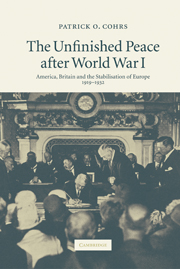Book contents
- Frontmatter
- Contents
- Acknowledgements
- List of abbreviations
- A note on the footnotes and bibliography
- Introduction
- Prologue
- 1 The wider challenges
- 2 Wilson, Lloyd George and the quest for a ‘peace to end all wars’
- 3 The ill-founded peace of 1919
- 4 The escalation of Europe's post-Versailles crisis, 1920–1923
- Part I The Anglo-American stabilisation of Europe, 1923–1924
- Part II Europe's nascent Pax Anglo-Americana, 1924–1925
- Part III The unfinished transatlantic peace order: the system of London and Locarno, 1926–1929
- 17 Sustaining stability, legitimating peaceful change
- 18 Progressive visions and limited commitments
- 19 ‘Reciprocity’?
- 20 The new European concert – and its limits
- 21 Thoiry – the failed quest for a ‘final postwar agreement’
- 22 Towards peaceful change in eastern Europe?
- 23 Achievements and constraints
- 24 No ‘new world order’
- 25 The initiation of the Young process
- 26 The last ‘grand bargain’ after World War I
- Epilogue
- Conclusion
- Map: Post-World War I Europe after the peace settlement of Versailles
- Bibliography
- Index
22 - Towards peaceful change in eastern Europe?
The crux of transforming Polish–German relations
Published online by Cambridge University Press: 21 July 2009
- Frontmatter
- Contents
- Acknowledgements
- List of abbreviations
- A note on the footnotes and bibliography
- Introduction
- Prologue
- 1 The wider challenges
- 2 Wilson, Lloyd George and the quest for a ‘peace to end all wars’
- 3 The ill-founded peace of 1919
- 4 The escalation of Europe's post-Versailles crisis, 1920–1923
- Part I The Anglo-American stabilisation of Europe, 1923–1924
- Part II Europe's nascent Pax Anglo-Americana, 1924–1925
- Part III The unfinished transatlantic peace order: the system of London and Locarno, 1926–1929
- 17 Sustaining stability, legitimating peaceful change
- 18 Progressive visions and limited commitments
- 19 ‘Reciprocity’?
- 20 The new European concert – and its limits
- 21 Thoiry – the failed quest for a ‘final postwar agreement’
- 22 Towards peaceful change in eastern Europe?
- 23 Achievements and constraints
- 24 No ‘new world order’
- 25 The initiation of the Young process
- 26 The last ‘grand bargain’ after World War I
- Epilogue
- Conclusion
- Map: Post-World War I Europe after the peace settlement of Versailles
- Bibliography
- Index
Summary
German attempts at achieving a peaceful revision of the postwar status quo were of course not limited to Franco-German relations. They also extended to eastern Europe, above all to relations with Poland. The problem of how to pave the way for a settlement of Polish–German disputes had been comparatively sidelined at Locarno to achieve a conclusion of the western security pact. But it is also worth noting again that it was at Locarno, too, that the problem of how to settle the inevitable disputes over the contested border of 1919 and the status of minorities on both sides of that border had been seriously broached for the first time since the victors had created it at Versailles. In a wider perspective, only the advances of London and Locarno created a modicum of what preconditions had to be established to embark on the up-hill trajectory of approaching a postwar accommodation between Warsaw and Berlin. And only these advances had set the stage for ultimately even envisaging an ‘eastern Locarno’ which extended the European concert to a wider security system that also regulated relations between Weimar Germany, the states situated uneasily between it and the Soviet Union – and eventually also the Soviet Union itself.
What impact did the politics of London and Locarno have on Polish–German relations in the latter 1920s? How far could these relations indeed be pacified, and how far could and did the Anglo-American powers make any contributions to this process?
- Type
- Chapter
- Information
- The Unfinished Peace after World War IAmerica, Britain and the Stabilisation of Europe, 1919–1932, pp. 409 - 416Publisher: Cambridge University PressPrint publication year: 2006



